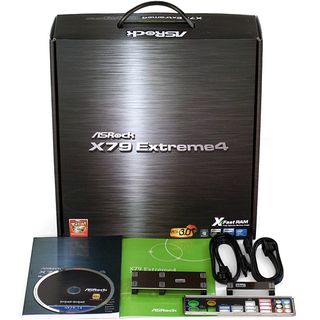Six $200-$260 LGA 2011 Motherboards, Reviewed
We know that Intel's X79 Express platform hosts the fastest desktop processors in the company's portfolio. But can it be made more affordable? We round up the least-expensive $200-$260 motherboards to determine how much you have to give up for cheap X79.
ASRock X79 Extreme4
ASRock’s continued effort to provide higher-end hardware without letting this platform's inherent price premium get out of control is easily illustrated in an X79 Extreme4 that has three extra SATA 6Gb/s ports, eSATA, dual-controller USB 3.0 for internal and I/O ports, and a full set of O/C-friendly features.

Those O/C-friendly features include a Port 80 diagnostics display, an I/O panel CLR_CMOS button, internal power and reset buttons for bench testing, and a eight-phase CPU voltage regulator with oversized cooling.

Front-panel USB 3.0 and one of the added SATA ports are found above-center on the motherboard’s front edge for easy reach of front-panel connector cables. Conversely, the front-panel audio cable is located as far away from any front-panel connectors as it could possibly be, at the rear of the X79 Extreme4’s bottom edge. Remaining ports are designed to coexist with up to three double-slot graphics cards, and ASRock even adds an extra space between the board’s two true x16 PCIe slots for additional graphics cooling.
The provision of a full feature set on a low-cost board is never free of compromise, as the X79 Extreme4 has only four memory slots. Although you'd have to decide right away whether to use 2 GB, 4 GB, or 8 GB modules to achieve quad-channel functionality without any option for future memory expansion, low memory prices make this a reasonable production-cost concession in our minds.

This is the first ASRock Extreme-series board in recent memory not to include the firm’s USB 3.0 front-panel bay adapter. We partly credit case manufacturers with making this part unnecessary, as removing it allows ASRock to further reduce cost and pricing.
We would have liked to see more than four SATA cables, however, even though this is probably enough to serve the budget-enthusiast market.
Stay on the Cutting Edge
Join the experts who read Tom's Hardware for the inside track on enthusiast PC tech news — and have for over 25 years. We'll send breaking news and in-depth reviews of CPUs, GPUs, AI, maker hardware and more straight to your inbox.
Current page: ASRock X79 Extreme4
Prev Page Can LGA 2011 Be Made More Affordable? Next Page X79 Extreme4 Firmware-
I like Asrock boards. I have an 880GM-LE mATX and a Z68 Pro3 Gen3 ATX and both are good performance and price-performance wise.Reply
-
hellfire24 Asrock is dominating both high end and mid range market.extreme3/gen3 1155 is awesome and cheapest pci-e 3.0 sli capable mobo.Asrock FTW!!!Reply -
Achoo22 ReplyQuite simply, the costs associated with Sandy Bridge-E are higher, in part because of Intel's prices and also because the boards are more difficult to design.
Since the boards all have vastly superior profit margins, your statement is misleading. Why is everyone too afraid to reveal the truth about motherboard pricing? -
AlexIsAlex Would it be possible, in future motherboard reviews, to include a measure of the cold boot (POST) time? This is something that different bioses can be differentiated on, and UFEI offers the potential for very fast boots if manufacturers take advantage of it properly.Reply
A comparison of the time between the power button being pressed and the installed bootloader starting would be very interesting to me. I was thinking it might be easiest to measure this by having no OS on the boot media and measuring the time to the "please insert boot media" message, but I'm sure you can think of other ways of doing it.
I'm also informed that on some boards the boot time varies dramatically dependent on whether any Overclocking is enabled, as compared to the stock settings - that would also be worth knowing. -
americanbrian your feature table says the asrock extreme 4 comes with an 8 phase voltage regulator, but the text of article says 10 phase...which is it ?Reply -
KT_WASP crisan_tiberiuASRock = ASUSReply
not anymore, asrock is no longer affiliated with Asus and is owned by Pegatron Corp. -
memadmax I wish tom's would do a "best motherboards for the money" or something close to that.Reply
Most Popular


